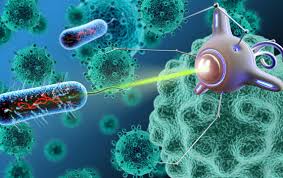
CONTENT
This course introduces students to the selected areas in nanobiotechnology – the field which employs nanoscience for biomedical applications. The students will learn how artificial entities can support their biological counterparts. The course helps students to better understand health impacts and the risks of nanoscience and technology by obtaining an introduction to nanotoxicology. For all topics, basic knowledge, key concepts, and real experiments will be discussed.
LEARNING OBJECTIVES
This course covers the following areas in nanobiotechnology:
•General overview over basic biochemical, biotechnological and nanobiotechnological concepts
•Self-assembly of proteins, lipids, DNA and other biomolecules
•Artificial and “green” enzymes, and their applications
•Biomedical applications of nanobiotechnological tools
•Nanotoxicology
Knowledge
At the end of the course, the students should be able to:
•Describe basic concepts in cell biology.
•Describe the self-assembling properties of proteins, peptides lipids and nucleic acids.
•Describe the use of unnatural amino acids to modify protein properties.
•Explain how supramolecular molecules can function as catalysts.
•Explain how enzymes and catalysts can be applied in nanobiotechnology.
•Explain the use of nanobiofabrication for medical applications such as tissue engineering, disease.
•Modeling, biosensing, and therapeutics/diagnostics products.
•Explain concepts, challenges, and techniques within the toxicology of nanomaterials.
Skills
Apply the above knowledge to evaluate and characterize nanobiotechnological systems.
Competencies
Read and analyze nanobiotechnology literature, present and evaluate this work in a concise manner, and write a reflective self-consistent essay on it. Write and evaluate specific nanobiotechnology concepts, techniques, and literature reviews.
This course introduces students to the selected areas in nanobiotechnology – the field which employs nanoscience for biomedical applications. The students will learn how artificial entities can support their biological counterparts. The course helps students to better understand health impacts and the risks of nanoscience and technology by obtaining an introduction to nanotoxicology. For all topics, basic knowledge, key concepts, and real experiments will be discussed.
LEARNING OBJECTIVES
This course covers the following areas in nanobiotechnology:
•General overview over basic biochemical, biotechnological and nanobiotechnological concepts
•Self-assembly of proteins, lipids, DNA and other biomolecules
•Artificial and “green” enzymes, and their applications
•Biomedical applications of nanobiotechnological tools
•Nanotoxicology
Knowledge
At the end of the course, the students should be able to:
•Describe basic concepts in cell biology.
•Describe the self-assembling properties of proteins, peptides lipids and nucleic acids.
•Describe the use of unnatural amino acids to modify protein properties.
•Explain how supramolecular molecules can function as catalysts.
•Explain how enzymes and catalysts can be applied in nanobiotechnology.
•Explain the use of nanobiofabrication for medical applications such as tissue engineering, disease.
•Modeling, biosensing, and therapeutics/diagnostics products.
•Explain concepts, challenges, and techniques within the toxicology of nanomaterials.
Skills
Apply the above knowledge to evaluate and characterize nanobiotechnological systems.
Competencies
Read and analyze nanobiotechnology literature, present and evaluate this work in a concise manner, and write a reflective self-consistent essay on it. Write and evaluate specific nanobiotechnology concepts, techniques, and literature reviews.

